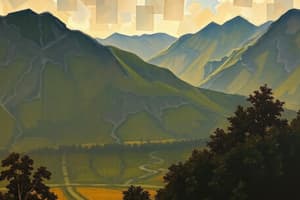Podcast
Questions and Answers
¿Cuál de las siguientes afirmaciones define mejor la geografía física?
¿Cuál de las siguientes afirmaciones define mejor la geografía física?
- Examina los sistemas de información geográfica.
- Analiza la economía de las poblaciones.
- Se enfoca en características naturales y procesos. (correct)
- Estudia las distribuciones sociales y culturales.
¿Qué se entiende por 'sostenibilidad' en geografía?
¿Qué se entiende por 'sostenibilidad' en geografía?
- La migración de personas hacia áreas urbanas.
- El impacto de las actividades humanas en el medio ambiente. (correct)
- La creación de mapas detallados.
- El uso de recursos sin considerar el medio ambiente.
¿Cuál es el propósito principal de la cartografía?
¿Cuál es el propósito principal de la cartografía?
- Estudiar las culturas de diferentes regiones.
- Gestionar recursos naturales.
- Analizar la economía local.
- Crear representaciones visuales de información geográfica. (correct)
¿Qué es el análisis de datos geográficos?
¿Qué es el análisis de datos geográficos?
¿Qué define mejor el concepto de 'escala' en geografía?
¿Qué define mejor el concepto de 'escala' en geografía?
En el contexto geográfico, ¿qué significa 'región'?
En el contexto geográfico, ¿qué significa 'región'?
¿Cuál de las opciones describe mejor la geografía humana?
¿Cuál de las opciones describe mejor la geografía humana?
¿Qué herramientas se utilizan comúnmente en la geografía?
¿Qué herramientas se utilizan comúnmente en la geografía?
Flashcards
Geografía
Geografía
El estudio de la superficie de la Tierra, sus características y los procesos que la dan forma.
El alcance de la geografía
El alcance de la geografía
Estudia los fenómenos espaciales y las relaciones entre los humanos y el medio ambiente.
Geografía física
Geografía física
Se enfoca en características, procesos y patrones naturales, como el clima, las formas del terreno, la hidrología y la biogeografía.
Geografía humana
Geografía humana
Signup and view all the flashcards
Geografía ambiental
Geografía ambiental
Signup and view all the flashcards
Ubicación
Ubicación
Signup and view all the flashcards
Lugar
Lugar
Signup and view all the flashcards
Región
Región
Signup and view all the flashcards
Study Notes
Introduction to Geography
- Geography is the study of Earth's surface, its features, and the processes shaping them.
- It analyzes the spatial distribution of phenomena globally, and the relationships between humans and the environment.
- Geography encompasses both physical and human aspects of the world.
Branches of Geography
- Physical Geography: Focuses on natural features, processes, and patterns, including climate, landforms, hydrology, soils, and biogeography.
- Human Geography: Examines the spatial distribution of human populations, activities, and cultures, such as population studies, urban studies, economic geography, political geography, and cultural geography.
- Environmental Geography: Focuses on human-environment interactions, often related to resource management, conservation, and environmental problems.
- Cartography: The science of mapmaking and representing geographic information.
- Geographic Information Systems (GIS): Using computer systems to capture, store, analyze, and display geographic data.
Key Concepts in Geography
- Location: A place's position on Earth's surface, either absolute (latitude/longitude) or relative (compared to other places).
- Place: A location's unique characteristics, including physical features, human modifications, and cultural attributes.
- Region: An area with shared characteristics like climate, culture, or economy.
- Spatial Interaction: The movement of people, goods, and ideas between places.
- Scale: The level of detail in geographic analysis, ranging from local to global.
- Sustainability: How human activities impact the environment and the need for long-term environmental protection.
Methods in Geography
- Fieldwork: Direct observation and data collection in the real world.
- Remote Sensing: Using satellites and aircraft to collect data from a distance.
- Geographic Data Analysis: Using statistical methods and computer tools to analyze geographic data.
- Mapping: Creating visual representations of geographic information.
Geographic Tools
- Maps (topographic, thematic, political): Visual representations of geographic information.
- Globes: Three-dimensional representations of Earth.
- Global Positioning Systems (GPS): Use of satellites to determine location.
- Geographic Information Systems (GIS) software: Software for capturing, storing, analyzing, and displaying geographic data.
Importance of Geography
- Understanding the world's diverse environments and cultures.
- Effective resource management.
- Identifying and addressing global challenges.
- Improved decision-making in various sectors.
- Enhanced understanding of human-environment interactions.
Studying That Suits You
Use AI to generate personalized quizzes and flashcards to suit your learning preferences.




